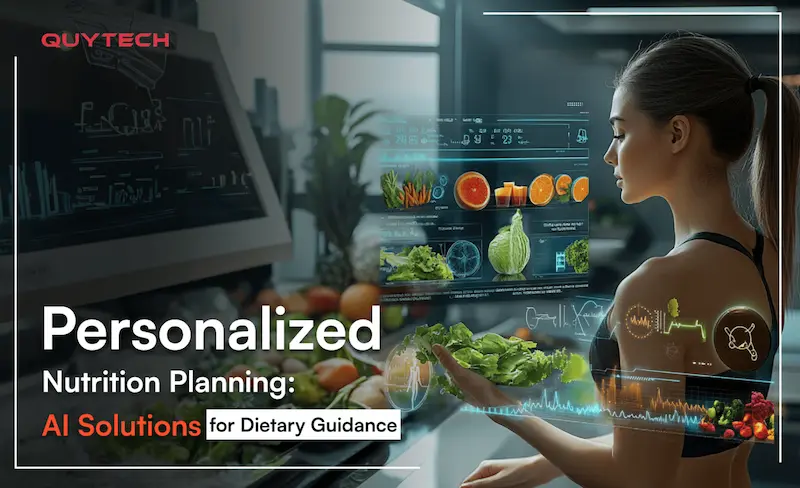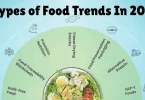Food is more than just something we eat—it’s innovation, culture, and a reflection of society. As we move into 2025, the top future food innovations to watch are transforming how we grow, cook, and enjoy meals, from personalized nutrition to sustainable farming.
Technologies like AI, biotechnology, and smart appliances are making food smarter, healthier, and more exciting. Yet challenges like data privacy, inequality, and climate impacts remain pressing.
For instance, recent floods in Venice disrupted local markets and food deliveries, showing how connected and vulnerable our food system is. With 2024 being the hottest year on record, supporting farmers and ensuring food security has never been more urgent.
Against this backdrop, food innovation isn’t just a trend—it’s essential. Let’s explore the top future food innovations to watch in 2025 and beyond.
1. AI-Powered Personalized Nutrition

Imagine walking into your kitchen, opening your fridge, and seeing recommendations for what to eat today—customized just for you. This is no longer science fiction. AI-powered nutrition platforms can analyze your health data, dietary preferences, and even genetic information to recommend foods that optimize your well-being.
These technologies go beyond simple calorie counting. For example:
- Smart meal apps suggest recipes tailored to your nutrient needs and lifestyle.
- Wearable devices track your activity and metabolic health to provide real-time dietary guidance.
- Smart fridges and kitchen appliances can even monitor food freshness and suggest recipes to reduce waste.
This personalized approach allows people to proactively manage their health, making nutrition more precise and effective than ever before.
2. Lab-Grown and Cultivated Meats
Sustainable protein sources are critical in the fight against climate change. Lab-grown or cultivated meats are produced by culturing animal cells in controlled environments, delivering the same taste and texture as conventional meat but with a significantly smaller environmental footprint.
Benefits include:
- Lower greenhouse gas emissions compared to traditional livestock farming.
- Reduced land and water usage, helping preserve ecosystems.
- Ethical advantages, as no animals are harmed during production.
As companies refine production methods, lab-grown meats are becoming more cost-effective, bringing them closer to mainstream adoption. In the near future, we could see these products widely available in supermarkets and restaurants.
You may also like to read this:
Top Insights on What Are the Latest Food Industry Trends
How Plant-Based Foods Are Changing Diets – Complete Guide
Types of Food Trends In 2026: What’s Hot on Your Plate
Why Clean Eating Is More Than A Trend | Complete Guide
Top Best Trending Snacks In The Market For Snack Lovers
3. Climate-Resilient Crops
Extreme weather events are increasingly threatening traditional agriculture. To safeguard global food supplies, scientists are developing climate-resilient crops that can thrive in harsh conditions. These include:
- Drought-tolerant grains like wheat and maize.
- Flood-resistant rice varieties for regions prone to heavy rainfall.
- Heat-resistant vegetables that maintain yield despite rising temperatures.
These innovations not only help farmers adapt to climate change but also ensure consistent food production, supporting global food security and reducing the risk of shortages.
4. Functional and Health-Boosting Foods
Today’s consumers are looking for more than just taste—they want foods that support health and wellness. Functional foods fortified with probiotics, prebiotics, vitamins, minerals, or bioactive compounds are becoming increasingly popular.
Some exciting developments include:
- Gut-friendly snacks containing probiotics to improve digestion.
- Cognitive-boosting beverages with ingredients like omega-3s or ginkgo biloba.
- Energy-enhancing meals designed to support mental clarity and physical performance.
With these foods, your plate becomes more than just nourishment—it becomes a tool for optimizing health, mood, and longevity.
5. Sustainable Packaging and Zero-Waste Practices
The future of food isn’t just about what we eat—it’s also about how it’s packaged. Sustainable packaging and zero-waste practices are becoming essential as consumers demand eco-conscious solutions. Innovations include:
- Edible packaging made from seaweed or rice paper.
- Biodegradable containers that break down naturally without harming the environment.
- Packaging-free retail models where customers bring their own containers.
These solutions reduce plastic waste, lower carbon footprints, and encourage more responsible consumer behavior, aligning food production with environmental stewardship.
6. Alternative Dairy and Plant-Based Innovations
Plant-based foods have moved from niche markets to mainstream diets, offering sustainable and nutritious alternatives to animal products. Beyond almond or soy milk, the latest innovations include:
- Oat-based cheeses that mimic traditional dairy textures.
- Legume and pea protein milks with higher protein content.
- Hybrid dairy products combining plant and animal ingredients for optimal taste and nutrition.
These alternatives reduce the environmental impact of dairy farming while meeting the growing demand for diverse and flavorful options.
7. Smart Kitchens and Automated Cooking

The kitchen of the future is smart, automated, and incredibly efficient. With AI-powered appliances, you can:
- Get recipe suggestions based on available ingredients.
- Adjust cooking times and temperatures automatically for perfect results.
- Utilize robotic cooking systems for meal prep without human intervention.
Smart kitchens make it easier to prepare healthy meals, save time, and reduce food waste, transforming how people approach cooking at home.
8. Food as a Lifestyle Experience
Food is increasingly becoming an immersive, multisensory experience. Innovations in dining and culinary technology are redefining how we enjoy meals. Examples include:
- AR/VR-enhanced meals that transform eating into interactive experiences.
- Personalized flavor journeys where tastes and aromas are tailored to individual preferences.
- Immersive dining events combining technology, art, and gastronomy.
These experiences make eating more engaging and memorable, blurring the lines between nutrition, entertainment, and social connection.
9. Blockchain and Food Transparency
In the era of conscious consumption, people want to know exactly where their food comes from. Blockchain technology is emerging as a powerful tool to provide complete transparency in the food supply chain. By securely recording every step of production, distribution, and sale, blockchain allows consumers to trace:
- The origin of their fruits, vegetables, or meats.
- Farming practices, including pesticide use and ethical standards.
- Transportation methods and storage conditions for maximum freshness.
This level of transparency not only builds trust between producers and consumers but also encourages more sustainable and ethical practices across the industry.
10. Edible Insects and Alternative Proteins
Insects are gaining recognition as a highly sustainable protein source. They require minimal land, water, and feed compared to conventional livestock while providing essential nutrients like protein, vitamins, and minerals. Expect to see:
- Cricket protein powders in baked goods and energy bars.
- Mealworm-based snacks and pasta.
- Insect-infused protein shakes or powdered supplements.
While the idea may seem unusual in some cultures, insects are already a staple in others. With innovative recipes and marketing, edible insects are poised to become a mainstream alternative protein source.
11. Vertical and Urban Farming
Urbanization is pushing agriculture into cities, creating opportunities for vertical and urban farming. Using hydroponics, aeroponics, and controlled environment agriculture, these farms can:
- Grow fresh produce year-round regardless of outdoor climate.
- Reduce transportation emissions by supplying local communities directly.
- Optimize resource use, consuming up to 90% less water than traditional farming.
Vertical farms are not just about efficiency—they bring farming closer to consumers, enhancing freshness and reconnecting people with the source of their food.
12. Food Waste Reduction Technologies
Globally, nearly one-third of food produced is wasted. Emerging technologies are tackling this issue head-on. Innovations include:
- AI-powered inventory systems in supermarkets to predict demand and reduce spoilage.
- Apps connecting excess food from restaurants to people in need.
- Smart preservation technologies that extend the shelf life of perishable items.
Reducing food waste benefits both the environment and the economy, creating a more sustainable and resilient food system.
13. Culinary Biotechnology
Biotechnology is not only producing lab-grown meats but also creating novel ingredients and flavors. Some exciting developments include:
- Microbial fermentation to produce natural flavors, proteins, and enzymes.
- Algae-based foods rich in nutrients and sustainable to produce.
- Custom-designed ingredients that enhance texture, flavor, or nutritional value.
These innovations have the potential to revolutionize food production while reducing environmental impact.
14. Immersive Food Retail Experiences
Future food shopping is becoming experiential. Supermarkets, restaurants, and cafes are experimenting with:
- Interactive displays and smart mirrors that provide recipe suggestions.
- Virtual reality experiences that show the journey of food from farm to table.
- Personalized shopping experiences based on AI-driven preferences and dietary goals.
This trend blurs the line between shopping, entertainment, and education, making food experiences more engaging and memorable.
15. Global Fusion and Flavor Innovation
As global connectivity increases, so does the fusion of culinary traditions. Future food innovations will see:
- Ingredients and cooking techniques from around the world blending in unique ways.
- New flavor profiles that combine nutrition with sensory delight.
- Food products designed to meet cultural, ethical, and health preferences simultaneously.
These innovations not only satisfy evolving taste preferences but also promote cultural exchange and creativity in the culinary world.
Looking Ahead
The top future food innovations to watch are reshaping the way we think about eating, farming, and sustainability. From AI-powered personalized nutrition to lab-grown meats, urban farming, and blockchain transparency, the next generation of food is smarter, greener, and more personalized than ever.
Consumers will have more choices, farmers will have more resilient tools, and the planet will benefit from more sustainable practices. As technology, science, and creativity converge, the future of food promises to be exciting, ethical, and health-focused.
The question is no longer what will we eat tomorrow?—it’s how will we experience food in ways that nourish our bodies, respect the planet, and celebrate culture? The answer lies in innovation, and the next bite you take could very well be the taste of the future.
FAQs
1. What are future food innovations?
Future food innovations are new technologies, products, and practices transforming the way we produce, prepare, and consume food. They aim to make food healthier, more sustainable, and personalized for individual needs.
2. How is AI changing the food industry?
AI is revolutionizing the food industry by enabling personalized nutrition, predicting food trends, reducing waste, and even assisting in smart kitchen automation. It helps consumers make healthier choices and supports more efficient food production.
3. What is lab-grown meat, and is it safe to eat?
Lab-grown or cultivated meat is produced by culturing animal cells in a controlled environment. It is safe to eat and provides the same taste and texture as conventional meat while reducing environmental impact and ethical concerns.
4. How are climate-resilient crops important?
Climate-resilient crops are designed to withstand extreme weather conditions like drought, floods, and heat. They help ensure stable food production, support farmers, and contribute to global food security in the face of climate change.
5. What are functional foods?
Functional foods are foods designed to provide additional health benefits beyond basic nutrition. Examples include probiotics, energy-boosting meals, and foods fortified with vitamins or bioactive compounds.





